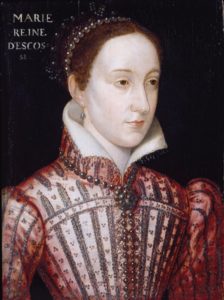Mary Queen of Scots (December 1542 – February 1587) was queen of Scotland from 1542 to 1567 and queen consort of France from 1559 to 1560. She became queen of Scotland when she was just 6 days old, her father James V of Scotland had died from injuries sustained at the Battle of Solway Moss and she was his only surviving, legitimate child.
Due to her extreme youth when she became queen, she had regents to rule Scotland while she grew up. To protect her from the English, Scotland reformed the Auld Alliance with France and sent her to France to be brought up at the French court and to marry the Dauphin of France, the future Francis II. Unfortunately Francis died just over a year into his reign due to a middle ear infection which spread to his brain. Newly widowed Mary returned to Scotland 9 months later.
Mary was in a vulnerable position; she no longer had the support of France through her marriage, and she had created animosity with her cousin, Elizabeth, Queen of England. Her father-in-law Henry II of France had actively encouraged Mary to pursue England when Elizabeth came to the throne. Henry VIII’s Last Will and Testament had put Elizabeth behind her brother Edward VI and Mary I and cut the Stuart line out of the succession. However because Elizabeth had been declared illegitimate when her mother Anne Boleyn had been beheaded for treason, and was a Protestant, many English Catholics supported Mary for the throne. While Elizabeth faced problems from her Catholic subjects, Mary faced problems from her Protestant subjects.
Four years after her return to Scotland Mary married her cousin, Henry Stuart, Lord Darnley. They had one son; James, the future James VI of Scotland and James I of England. Their match started as a love match for Mary, but it didn’t please Elizabeth, who felt threatened by the match. Mary and Darnley both shared the same grandmother, Margaret Tudor the sister of Henry VIII, and thus any children they had would have a doubly strong claim to the English throne. However Darnley grew arrogant and wanted more than to be king consort, he requested to be made co-sovereign of Scotland and to be allowed to keep the throne if Mary died before him. Mary denied his request and it caused strain on their relationship. In February 1567 Darnley was murdered, and it was generally believed that the Earl of Bothwell who was behind it.
Bothwell was brought to trial, but was acquitted after a 7 hour trial. Bothwell then kidnapped Mary (it is unknown if she went willingly) and she later married Bothwell, who had divorced his wife 12 days before. This was the beginning of the end for Mary‚Äôs reign in Scotland. Her people were horrified that she would marry the man accused of her husband’s death. Mary was forced to abdicate in favour of her one year old son. Mary then fled to England, mistakenly believing Elizabeth would help her reclaim her throne.
There was an unusual trial to decide whether Mary was guilty of being involved in Darnley’s murder, but there was no real decision either way, but Mary was kept in custody in England by Elizabeth. While Mary was imprisoned she continued to plot against Elizabeth for the throne of England, and she was arrested after being implicated in a plot to assassinate Elizabeth and replace her and she was executed for treason.
It is difficult not to compare Mary to her much more successful cousin. They both ruled kingdoms in a time of major religious conflict, were both unusual in being women rulers in a man’s world, however, Elizabeth managed to weather the storms much more successfully than Mary.
-Danielle Triggs
Junior Girl
Girl Museum Inc.

